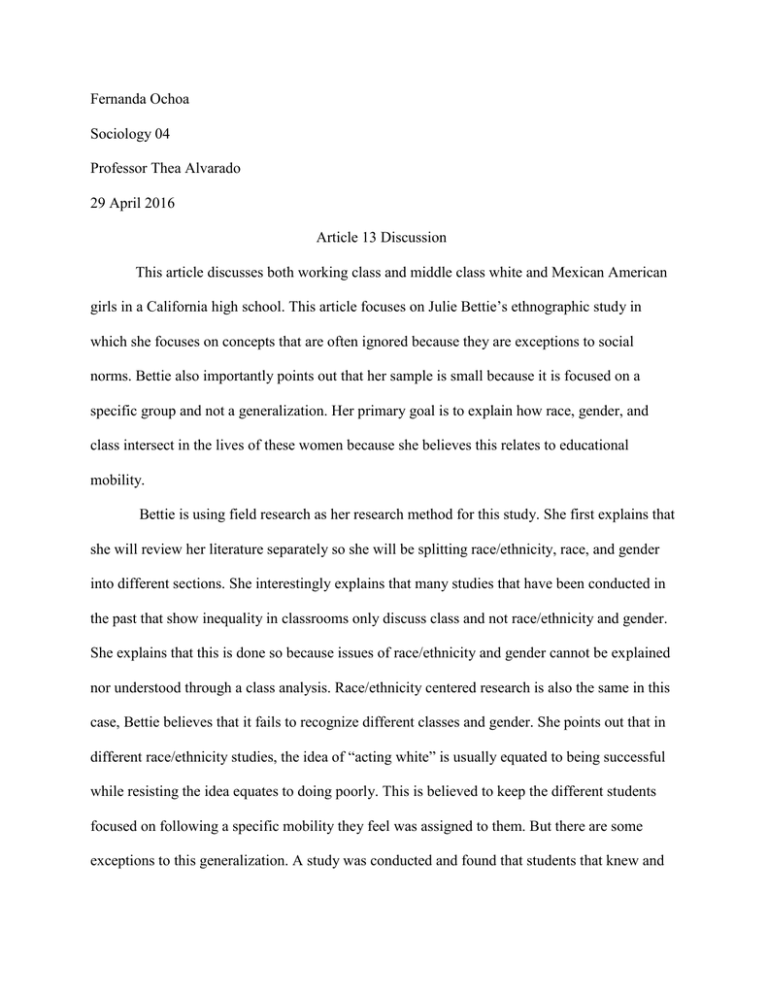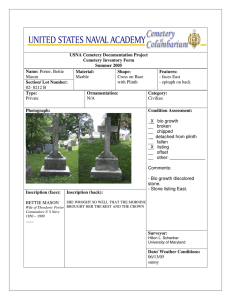Article13.docx
advertisement

Fernanda Ochoa Sociology 04 Professor Thea Alvarado 29 April 2016 Article 13 Discussion This article discusses both working class and middle class white and Mexican American girls in a California high school. This article focuses on Julie Bettie’s ethnographic study in which she focuses on concepts that are often ignored because they are exceptions to social norms. Bettie also importantly points out that her sample is small because it is focused on a specific group and not a generalization. Her primary goal is to explain how race, gender, and class intersect in the lives of these women because she believes this relates to educational mobility. Bettie is using field research as her research method for this study. She first explains that she will review her literature separately so she will be splitting race/ethnicity, race, and gender into different sections. She interestingly explains that many studies that have been conducted in the past that show inequality in classrooms only discuss class and not race/ethnicity and gender. She explains that this is done so because issues of race/ethnicity and gender cannot be explained nor understood through a class analysis. Race/ethnicity centered research is also the same in this case, Bettie believes that it fails to recognize different classes and gender. She points out that in different race/ethnicity studies, the idea of “acting white” is usually equated to being successful while resisting the idea equates to doing poorly. This is believed to keep the different students focused on following a specific mobility they feel was assigned to them. But there are some exceptions to this generalization. A study was conducted and found that students that knew and studied about colonialism and institutional racism helped upward mobility. Gender is often ignored in both of the research topics before. Unfortunately, there are also gender studies that only focused on the difference between male and female students and did not focus on race/ethnicity nor class so was not able to account for many groups, thus not being intersectional. Many studies have ignored the struggles that female students have faced while receiving their education, leaving many stories unheard. There is little research on specific things such as the difference between working class women and their male counterparts, ignoring the intersectionality, once again. What was interesting was that Bettie quickly examines studies done on Chicanas that focus on their successes as opposed to their male counterparts, whether working class or middle class. This is cut short when these same women are not able to get fair and equal job access to the same boys they went to school with. Bettie focuses her study on intersectional studies, instead of reducing each topic to a specific thing, she connects all of them together. Bettie conducted her study with 60 girls; 11 were upwardly mobile but of working-class origins, 5 were white and 6 were Mexican American. She notes that among college prep Mexican American girls in this senior class, only two were immigrants. Bettie is also limited to this study because she is only an English speaker. She also finds out the origins of this girls, meaning their socioeconomic background. Her study was conducted in a high school located in the Central Valley, called Waretown High. The population of this town is 40,000 and the high school is reflective of this population with there being sixty percent white students and forty percent Mexican American students. It is important to note the majority of the students that attend this high school are working class with the middle class being a minority. There is also only one private school located in this town but is only for elementary school. Bettie engaged in participant observation for one year at the high school and would hang out daily with girls in classrooms and hallways. She would meet different girls through teachers but mainly through friendship circles. Bettie also discusses the small obstacle she thought she was going to face as a white woman but found that though she was white, asking questions with relative topics to the Mexican American girls helped her gain her trust. She had interviews recorded of these different girls for approx. two hours. Bettie found that both sets of girls were aware of having exceeding their parents’ expectations. Both sets of girls also had a greater understanding of class differences relative to other working-class girls. Bettie also found that the there were less limitations on the white females had less obstacles in some ways than Mexican American girls. Mexican American girls often faced issues with identity and had to confront the idea of being pressured to forget their identity because of the educational curriculum but also were pressured by their peers to resist this idea. Bettie also concluded that upward mobility may also be informed by gender. In some of these cases, gender norms allowed women to continue on the expectations of a middle class lifestyle while men were encouraged to be more masculine. Another interesting thing Bettie found was that the upward middle class women were regarded as better than the girls who were focused on vocational studies. Though this was found in Bettie’s study, she did not conduct a study on the boys at the school on this same topic, therefore cannot argue this. Bettie also talks about the pressures of race and ethnicity and how there can be both positives and negatives. The positives being that there is a found motivation on learning about oppression but the negative being feeling pressured to represent a large group of people. Bettie also noticed that the white girls in this school did not feel pressured to feel like a part of a group but were more individualistic. Bettie also mentions that women of color are often pressured to forget their culture in order to succeed. She mentions that the working class girls are also often judged based on their income by counselors and are given courses that they feel they are able to take, even when they are able to take more.


